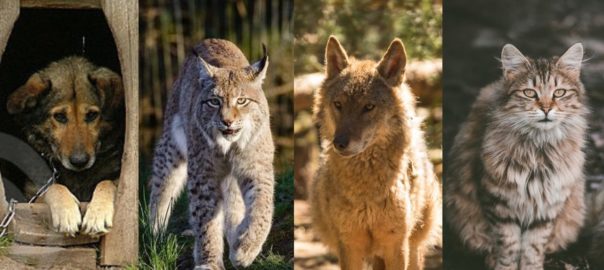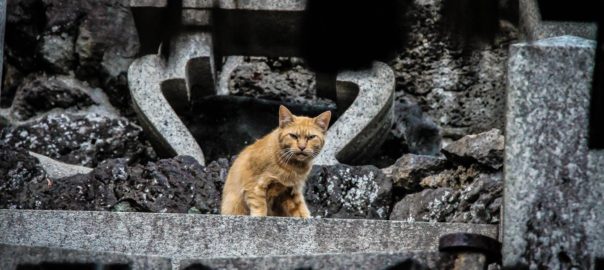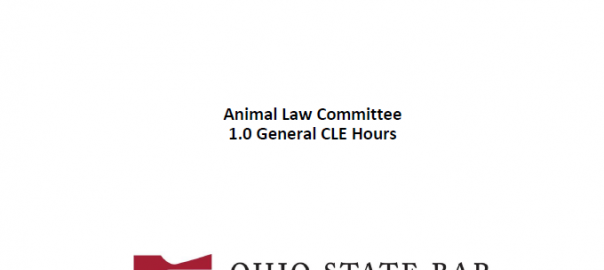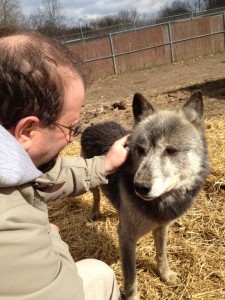
Mark J. Bamberger, Esq., Owner/Attorney at Law
The Mark Bamberger Co., LLC[1]
The Zanesville, Ohio exotic animal tragedy[2] received international publicity; not in a good way. There has always existed a tension between our love for wild animals, our concern for their safety and preservation, and the need for their rationale isolation from our community. Further, we have to consider limits on the intrusion upon the privacy and freedom of the individual owners. [3]
Sadly, we are far from the day when non-humans can have reasoned legal protections under our human-derived and human-intended legal system. Following Zanesville, there were some calls for an absolute ban on private ownership of wild and dangerous animals. This was an extreme approach in the eyes of some. Ohio’s Senate Bill 310 (and later House Bill 483) was proposed to maintain a balance between competing parties on this sensitive issue. It was carefully drafted; taking into account both the testimony from a wide variety of experts in the field of exotic and dangerous animals and from owners of such animals.[5] The need for this regulation was clear. The Governor’s office stated that “…while Ohio law is clear on the state’s authority to regulate native species of wild animals, it is unclear about the authority that the state has to regulate dangerous non-native species of wild animals”.[6] Also, “…[the] bill introduced in the [Ohio] State Legislature (SB 310/HB 483) would ban the acquisition, sale, and breeding of restricted species. If passed, the new law would: (1) Prohibit new possession of dangerous wild animals; (2) Prohibit all sales and transfers of dangerous wild animals; and (3) Authorize officials to inspect dangerous wild animals already in someone’s possession. Keeping wild and exotic animals as pets threatens public health and safety as well as animal welfare.[7]
Now signed into law, SB 310/HB 483 became the Exotic Animal Control Law (“EACL”) on June 5, 2012. It provides reasonable regulation of a highly risky, often unpredictable activity with the potential for sudden and widespread harm to our community. This regulation includes various requirements for the registration and training of the owners of exotic and dangerous animals. These includes mandates that owners and facilities owned or operated by them be appropriately inspected and insured and that such animals be humanely and carefully cared for, tracked (including the usage of microchips), transported and transferred from one permit holder to another. Finally, the EACL provides for a dangerous and restricted animal fund, into which shall be deposited permit application fees, fines, and other monies collected pursuant to provisions of the bill.
Sadly, many of these exotic animals were bought legally by Ohio residents as “trophy pets”. In some instances drug lords or those finding a personal zoo desirable bought these amazing animals and built make-shift cages and pens for them; without a clue as to the expense and expertise needed to properly care for them – let alone the abuse of caging a wild animal in a small suburban locale. Until recently, they were summarily killed by law enforcement when the drug lord was arrested or the zoo disbanded. Recently, there has been a movement to provide local sanctuary for those animals.[8] Two local examples of these are Wolf Creek Wolf Sanctuary & Rescue in Brookville, Indiana and Heaven’s Corner Zoo & Animal Sanctuary in West Alexandria, Ohio.
Perhaps most importantly, this legislation provides a reasoned balance between the rights of those who own or wish to own exotic animals and the safety of the general public. The language and spirit of the bill has been vetted by animal care experts and incorporates best practices in what can be a dangerous and volatile hobby/profession/etc. The bill is undeniably in response to the horrific images played around the world when one careless and mentally ill animal owner acted with complete disregard for his neighbors. While no legislation can guarantee the prevention of what occurred in Zanesville, this bill will create safeguards and regulations which give the government the power needed to monitor dangerous animal owners and protect the public from those who would fail to keep those animals responsibly.
The law, which becomes active in 2014, provides for formation of an advisory board, which consists of representatives from the state departments of agriculture and natural resources, the state veterinarian in the Ohio Department of Agriculture, representatives from the Association of Zoos and Aquariums, from the Zoological Association of America, veterinarians, humane societies, the governor’s office, the public at large, and from owners of such animals. The bill was also drafted according to generally accepted zoo and aquarium standards, and generally accepted veterinarian practices.
Tactically, this was an interesting political intersection of strange bedfellows. The conservatives in the Ohio Legislature were concerned about the infringement on personal liberties. Rep. Terry Boose (R-Norwalk), who was one of four members who voted against reporting the bill out of committee, believed the bill heavily encroached on people’s property rights. While he agreed that some regulations for exotic animals must be in place, he explained that SB310 was “overly restrictive.”[9] While some members tout the bill as creating stronger public protection against such actions, Boose believes the additional rules could make it more difficult for exotic animal owners to comply. “Just because you add more rules, doesn’t make it safe,” Boose explained. “I had too many people tell me in their testimony that — what happened in Zanesville — this bill will not stop, and it could happen all over again even with this bill.” Before reporting SB310 out of committee, Chairman Dave Hall (R-Killbuck) presented and saw passed an omnibus amendment that added several new provisions to the bill:
1. Requires the Ohio Department of Agriculture (ODAg) director to seek approval from the
Ohio General Assembly before adding new species to the definition of “Dangerous Wild Animal” and “Restricted Snake.”
2. Changes the ownership fees depending on the number of animals owned: an owner of one
to three dangerous animals would pay $250 a year; the owner of four to 10 dangerous animals would pay $500 a year; the owner of 10-15 dangerous animals would pay $1,000 a year; and owners of 16 animals would pay $1,000 a year plus an additional $125 per animal.
3. Exempts lemurs; pygmy, white-tufted-ear, silvery and black-penciled marmosets; squirrel
monkeys; and brown, white-faced, weeping and white-fronted capuchins. However, all animals must still be registered with ODAg at no fee.
4. Includes a representative from the boards of health on the Dangerous and Restricted Animal Advisory Board.
5. Permits the dangerous and restricted animal funds to be used to compensate boards of health for costs incurred while capturing dangerous wild animals and restricted snakes.
6. Prohibits rescue facility operators from purchasing dangerous wild animals.
7. Requires the wildlife shelter applicant to also submit a plan-of-action in the case of an animal escape to the local fire chief and
8. Excludes domesticated animals which are considered livestock from the definition of dangerous wild animal.
The committee also accepted an amendment presented by Rep. Tracy Maxwell Heard (D-Columbus) which allowed permissive language for local municipalities to keep their own exotic animal laws intact as long as the laws are more stringent than the laws included in SB310.[10] The bill was reported out of committee after a marathon session of 15 hours in which the testimony of 58 witnesses was taken.[11]
Conversely, the more liberal thinkers in the Legislature also were concerned about animal
rights and protections. On one hand they wanted to protect private owners’ rights to keep these animals. Yet they accepted the need for community protection. Many current owners believe the law went way too far. This author represents several clients who own animals classified as “wild”. Although they accept the strict legal liability statutes of such ownership, these animals are as much part of their family as dogs and cats are to most of us. They believe the law is too expensive and too restrictive for those owning one or two animals and will make such activity cost-prohibitive. They liken this regulation to “killing a mosquito with a 341 Magnum”.
Personally, the EACL legislation leaves this author conflicted. My love and adoration of non-human animals leads me to want them kept safe; and preferably in the wild where they are happy and safe – not in zoos or personal collections where they are often confined if not abused and tortured. Seeing a wolf or tiger or boa is a wonderful, moving experience. Seeing them in a little cage and knowing they cannot live out their natural lives as they would wish is heart wrenching. Countering those “tree hugging” feelings is the attorney in me who knows that regulation is mandatory to protect the greater good of the community. In protecting the community, the local police had no option but to execute those beautiful animals in Zanesville. That fact, in and of itself, told us that something was seriously wrong with the system we had. Until wild animal rescues and sanctuaries are established and promulgated through the region, these animals need our physical and legal protection. Perhaps the EACL is a good “first-step” to finding a way to balance that tension between love for animals and need for safety in our community.
[1] The Mark Bamberger Co., LLC is a general practice law firm with offices in Tipp City, West Chester, Enon, and Spring Valley, Ohio. TMBC focuses on animal and environmental law, family law, bankruptcy, employment law, civil and criminal litigation, and criminal defense.
[2] For those unaware, Mr. Terry Thompson of Zanesville freely and, at the time legally maintained a large cadre of more than 50 exotic animals, including various species of wild cats and bears (see picture above). These animals were abused and improperly feed and maintained. On October 19, 2011, Thompson brazenly and willfully released all of the wild and exotic animals into the community; then took his own life.
[3] Credit is given to Kyle Silvers, Esq., a founding member and the chairwoman of the Ohio Bar Association’s Animal Law Committee, for her generous and critical contribution to this article.
[4] Picture taken from http://thedailywh.at/2011/10/19/follow-up-of-the-day-sad-end-for-zanesvilles-wild-animals/
[5] Comments made by Kyle Silver, Esq. at the formal Senate hearings on this topic
[6] Quote taken from www.globalpost.com/dispatch/news/regions/americas/united-states/111021/john-kasich-executive-order
[7] Official statement regarding SB310 by The Animal Legal Defense Fund
[8] The author supports, for example, the Wolf Creek Wolf Rescue and Sanctuary, located in Brookville, Indiana. Wolf Creek’s mission is to save wild, wounded, and abused wolves and wolf hybrids from torture or euthanasia. Donations and other support is appreciated. See more at www.nighthowls7.com.
[9] Story originally published in The Hannah Report on May 16, 2012. Copyright 2012 Hannah News Service, Inc.
[11] Additional information was gathered from Mary Amos Augsburger, Esq., Legislative Counsel of Ohio State Bar Association
[12] Picture taken from http://thedailywh.at/2011/10/19/follow-up-of-the-day-sad-end-for-zanesvilles-wild-animals/









